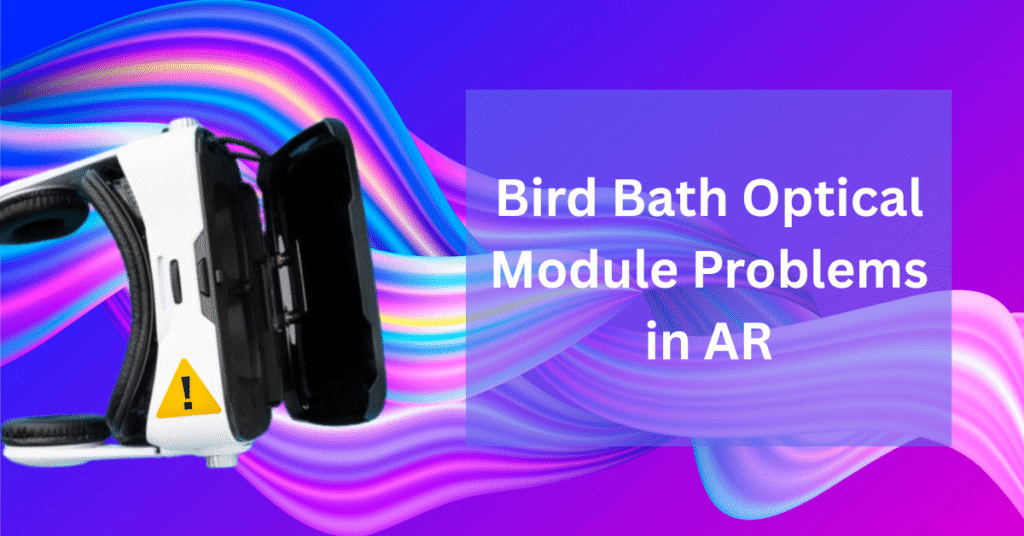Augmented Reality (AR) is transforming industries ranging from gaming and retail to healthcare and training. At the heart of many AR devices lies the bird bath optical module, a compact optical system that uses a semi-reflective lens to combine digital projections with the real world. While it delivers sharp visuals and lightweight design benefits, many users and developers face recurring challenges with this technology.
In this article, I will walk you through the most common bird bath optical module problems in AR devices, why they happen, and practical solutions you can use to fix or prevent them. Whether you are an AR developer, engineer, or enthusiast, this guide will help you maintain smoother performance and a better user experience.
Understanding the Bird Bath Optical Module in AR
Before diving into issues and fixes, it’s important to understand what the bird bath optical module does.
- It uses a concave mirror and beam splitter to reflect projected images into the user’s eyes.
- It helps achieve a lightweight, compact form factor for AR headsets compared to bulkier optical engines.
- It provides good brightness and clarity in controlled environments.
However, its reliance on reflective optics introduces unique challenges—especially when used in real-world, high-demand AR applications.
Common Problems with Bird Bath Optical Modules
1. Glare and Reflection Issues
One of the biggest drawbacks is glare caused by ambient light. Since the system relies on reflective surfaces, sunlight or strong indoor lighting can reduce image contrast.
2. Limited Field of View (FOV)
Many AR users complain that the FOV is narrow compared to waveguide-based displays. This creates a restricted immersive experience.
3. Image Distortion and Misalignment
Over time or due to manufacturing inconsistencies, images may appear warped, blurry, or misaligned, impacting usability.
4. Weight and Comfort Concerns
Although lighter than some optical systems, bird bath modules can still feel front-heavy, causing discomfort during long sessions.
5. Durability and Dust Issues
Since the design involves mirrors and lenses, dust, scratches, or coating damage can severely impact image quality.
Step-by-Step Solutions to Bird Bath Optical Module Problems
1. Fixing Glare and Reflection
- Use anti-reflective coatings on lenses and mirrors.
- Add light-shielding hoods or visors to block external light sources.
- Optimize device usage in controlled lighting environments.
2. Expanding Field of View
- Combine the bird bath module with custom-designed optics that slightly expand FOV.
- Use software rendering tricks to give the illusion of a wider field.
- Explore hybrid optical setups that balance weight and immersion.
3. Correcting Image Distortion
- Calibrate optical alignment during assembly and regularly during usage.
- Use software-based distortion correction to adjust projected visuals.
- Apply precision coatings to reduce lens warping effects.
4. Improving Comfort and Weight Balance
- Distribute weight using balanced headbands and ergonomic designs.
- Introduce lighter materials such as carbon fiber in AR headset frames.
- Allow modular adjustments, so users can shift weight for personal comfort.
5. Enhancing Durability
- Apply scratch-resistant coatings to mirrors and lenses.
- Seal optical modules against dust and humidity.
- Offer maintenance kits for safe lens cleaning and upkeep.
Preventive Maintenance Tips for AR Developers
To avoid recurring problems, developers and manufacturers can adopt these preventive practices:
- Quality Control: Ensure strict testing of optical alignment during production.
- Environmental Design: Consider the user’s environment—indoor vs. outdoor AR requires different optical coatings.
- Regular Updates: Provide firmware/software updates that include distortion correction algorithms.
- User Training: Educate end-users on proper cleaning and handling of devices.
Alternatives to Bird Bath Optical Modules in AR
Although bird bath optical modules remain popular, some companies are shifting toward waveguides, pancake optics, and holographic displays.
- Waveguides: Offer wider FOV and better outdoor usability, but cost more.
- Pancake Lenses: Provide thinner designs, though at the cost of brightness.
- Holographic Lenses: Still experimental but promise future scalability.
Understanding these alternatives helps AR developers decide whether to stick with bird bath optics or migrate to newer technologies.
Final Thoughts
The bird bath optical module has played a major role in making AR devices more accessible and compact. However, it comes with drawbacks like glare, narrow FOV, and durability challenges that can frustrate users if left unaddressed.
By applying **practical fixes—such as coatings, calibration, ergonomic designs, and software correction—**developers and manufacturers can extend the usability of this optical system. At the same time, keeping an eye on emerging alternatives ensures AR products remain competitive in the fast-changing immersive tech industry.
If you’re developing AR devices or troubleshooting existing ones, focus on both hardware optimization and user experience improvements to get the best results.

